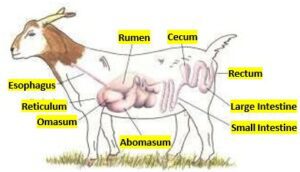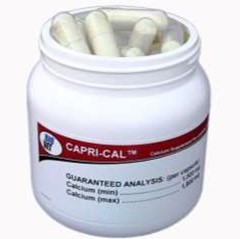Goats are small ruminant animals that have no upper incisors or canine teeth but a dental pad instead. The rumen is the largest part of the four stomach compartments, with a capacity of roughly 2-6 pounds. Some bacteria and protozoa are normal habitants of the rumen which break down food into volatile fatty acids along with vitamins and amino acids. Daily feed take of goats ranges from 3-4% of body weight as expressed in pounds (dry matter/head/day).
Goats are able to digest a large variety of fiber and roughages. Goats are efficient browsers and prefer eating brushy plants found on ranges. The nutrient requirements of goats are determined by age, sex, breed, production system (dairy or meat), body size, climate and physiological stage. Feeding strategies should be able to meet energy, protein, mineral, and vitamin needs depending on the condition of the goats. Goats do not depend on intensive feeding systems except some supplemental feeding during growth, lactation, pregnancy and winter. When goats are lactating for an extended period of time (i.e., 10 months), they will require supplemental feeding on a higher plane of nutrition (e.g., dairy quality second cut alfalfa hay and grain ration). Goat diets require essential nutrients such as carbohydrates, proteins, minerals, vitamins, and fats. Sugars, starches (found in grains) and fiber (cellulose) are the carbohydrates that convert into volatile fatty acids (energy) by rumen flora (beneficial bacteria).
A normal goat diet (browse, forbs, and grasses) is high in cellulose and requires digestion by rumen flora to be converted into energy. Fresh pastures and young plants may have highly digestible fiber and provide high energy compared to older plants. Higher energy levels come from lower fiber feeds. It is important to supply half of the goat ration in the form of hay or pasture to avoid high energy-related problems. Energy requirements for different physiological stages – maintenance, pregnancy, lactation and growth – vary. In the time of breeding, late gestation and lactation, goats will require high-energy rations. Proteins are digested and broken down into amino acids and are eventually absorbed in the small intestine. Those amino acids are building blocks for proteins (muscles). The rumen plays a major role in breaking down consumed protein into bacterial protein through bacterial fermentation.
Feeds like forages, hays, pellets (alfalfa), barley, peas, corn, oats, distilled grains and meals (soybean, canola, cottonseed meals) are common sources of protein for goat rations. Goats need certain minerals and vitamins for their maintenance as well as the proper functioning of their physiological systems. Rumen flora can make vitamin B in enough quantities needed for goat metabolism. Vitamin C is essential for the immune system to work efficiently. Feeding fat-soluble vitamins (A, D, E, K) must be insured in a goat’s diet due to its inability to make these vitamins. Feeding calcium and phosphorus (2:1 ratio) is recommended for better structural and bone strength, while other minerals are necessary for other systems like the nervous and reproductive. Minerals should be added into the feed keeping in mind the quality of forages as some forages can be high in some minerals and low in others.
Facts about Goats
- Goats have a gestation period of five months and the average birth rate for goats is 2 kids per year.
- Baby goats are called Female goats are called a doe. Male goats are called a buck or billy.
- Each kid has a unique call, and along with its scent, that is how its mother recognizes it from birth – not by sight.
- Goats pupils are This gives them vision for 320 to 340 degrees (compared to humans with 160-210) around them without having to move and they are thought to have excellent night vision.
- Both male and females have wattles as well. Wattles are bits of skin that dangle from their head or neck.
- Goats are extremely agile and excellent climbers with great balance.
- Goat meat is lower in fat and cholesterol compared to beef, pork and poultry.
- Like sheep, goats are seasonal The typical breeding season is between late August and early January.
- Many dairy goats, in their prime, average 6 to 8 pounds of milk daily (roughly 3 to 4 quarts).
Product of the Week: Capri-Cal, Calcium Capsule for Goats
Features:
-
-
-
-
-
-
- Designed to support both calcium and energy requirements in does, thus minimizing effects from hypocalcemia and
- Multiple calcium sources both absorb rapidly into the bloodstream and maintain calcium supply longer term.
- Highly available forms of Magnesium facilitate blood calcium regulation.
- Vitamin D plays a key role in calcium absorption and regulation.
- Fatty acids serve as energy sources that can be metabolized by the liver to meet glucose
- Niacin supports liver functions
-
-
-
-
-



